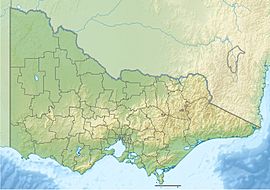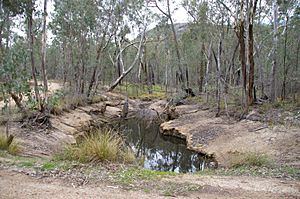Chiltern-Mt Pilot National Park facts for kids
Quick facts for kids Chiltern–Mt Pilot National ParkVictoria |
|
|---|---|
|
IUCN Category II (National Park)
|
|

Reedy Creek at Gladstone Track
|
|
| Nearest town or city | Chiltern |
| Established | 30 October 2002 |
| Area | 215.6 km2 (83.2 sq mi) |
| Managing authorities | Parks Victoria |
| Website | Chiltern–Mt Pilot National Park |
| See also | Protected areas of Victoria |
The Chiltern-Mt Pilot National Park is a special place in Victoria, Australia. It's a national park found in the Hume region. This park covers about 21,650 hectares (that's like 53,500 football fields!).
You can find it about 275 kilometers northeast of Melbourne. The park stretches from Beechworth west towards Chiltern. It even goes over the Hume Freeway and the Albury-Melbourne railway line!
The park was created to protect many amazing animals and plants. It has cool features like Woolshed Falls and the pretty Mt Pilot summit. You can also see ancient Aboriginal rock art at Yeddonba. Plus, there are old tools and buildings from the gold mining days. People love to visit for bushwalking, hiking, trail riding, and bird watching. You can also go rock climbing, picnicking, or camping here.
Contents
Discovering Chiltern-Mt Pilot National Park
A Look Back at the Park's History
Long ago, huge forests called box-ironbark forests covered much of Victoria. But when Europeans settled here, most of these forests were cut down. The remaining parts were also damaged by animals grazing.
The forests in Chiltern-Mt Pilot National Park show us what happened. Some of its natural areas were hurt by grazing, clearing land, logging, and mining.
Gold Rush Days
In the mid-1800s, gold was found in this area. People started digging for gold everywhere. You can still find signs of these activities today. Look for disturbed ground, piles of dirt, old dams, and mine shafts. Even today, you can still search for gems and gold in the park.
Timber and Grazing
In the 1930s, people discovered the strong timber from the box and ironbark trees. They cut them down for fences, buildings, and firewood. Collecting firewood continued until 2002 when the National Park was formed. This changed the forest from big, old trees to many smaller, closely packed trees.
Clearing land for farms and grazing animals also harmed the area. Grazing happened in parts of the park until the 1980s and 1990s. This caused problems like new pest plants and animals, soil damage, and less natural habitat.
How the Park Was Formed
The Chiltern-Mt Pilot National Park is actually two older parks joined together. Each part has its own unique rocks, history, and nature.
The Chiltern Regional Park (first called Chiltern State Park) was set aside in 1980. It was a 4,250-hectare box-ironbark forest. The Mt Pilot Multipurpose Park was also created around the same time.
Later, these two parks, along with Woolshed Falls and nearby land, were combined. This created the Chiltern-Mt Pilot National Park we know today in 2002. This made it a highly protected area for nature.
Nature's Wonders in the Park
The park has different types of land, from low hills to rugged granite areas. It protects 18 types of plant communities. Four of these are threatened, like the Box-Ironbark and Spring-soak Woodlands.
The park is home to over 600 native plant species. It also has more birds, mammals, and reptiles than any other box-ironbark forest. It's super important for two special animals: the barking owl and the brush-tailed phascogale. The park is also part of an "Important Bird Area." This means it's vital for protecting woodland birds.
Amazing Animals of the Park
The park is home to 276 different kinds of mammals, birds, and reptiles. You can see common animals like the grey kangaroo, koala, and laughing kookaburra. But it also protects 43 threatened animal species. Here are a few special ones:
Squirrel Gliders
The squirrel glider is a small, tree-dwelling marsupial. It's a threatened species. These gliders need specific trees for food and nests. They use trees to move around the forest. This means they are very sensitive to changes in the forest.
Squirrel gliders eat insects, nectar, and tree sap. They spend most of their nights looking for food in living eucalyptus trees. They especially like big, old trees with flowers. They also use dead trees for shelter and to help them move through the forest.
Brush-tailed Phascogales
Brush-tailed phascogales are small, meat-eating marsupials that live in trees. They are usually alone. All males die after breeding once a year. These animals are found across Australia. But habitat loss in Victoria means they are now threatened.
Phascogales eat mostly insects. They spend up to 90% of their nights hunting in trees. Larger trees offer more places for them to find food and more hollows for nests. They prefer big, old living trees and often have many nests. So, places with mature, well-spaced trees are best for them.
Barking Owls
The barking owl is a threatened species. It's one of the biggest predators left in southern Australia. These owls need a lot of high-energy food. This makes them very vulnerable if their habitat is broken up or damaged.
These owls protect their territory and need large trees for resting during the day. They are one of the largest animals in Australia that depend on tree hollows. So, old, mature trees are essential for big enough nesting spots. Droughts and bushfires have reduced their numbers. The Chiltern-Mt Pilot National Park is now crucial for helping them recover.
Regent Honeyeaters
Regent honeyeater populations have shrunk a lot. They are now nationally endangered. There are only about 1,500 left! These birds usually live in eucalyptus woodlands and dry open forests.
They mainly eat insects and nectar, sometimes fruit. In Victoria, they prefer box-ironbark forests. They especially love the nectar from yellow gum and red ironbark trees when they flower in winter.
Other Special Animals
Besides these, the park is home to many other important animals. These include the painted honeyeater, swift parrot, turquoise parrot, square-tailed kite, bandy bandy, and brown toadlet.
Wonderful Plants of the Park
The Chiltern-Mt Pilot National Park protects 42 threatened plant species. Ten of these are listed as threatened in Victoria. This includes rare orchids like the crimson spider orchid and yellow hyacinth-orchid. Other important plants are the Warby swamp gum and mountain swainson-pea.
Red Ironbark Trees
Red ironbark trees, also called mugga ironbark, grow 10 to 30 meters tall. They are found in open forests along the Great Dividing Range. These trees flower all year, with small flower buds appearing on their leaves. Small fruits grow about a month after flowering.
The swift parrot and regent honeyeater visit the park in winter. They come to feed on the red ironbark's nectar when it flowers most.
Black Cypress Pines
The park has the largest protected group of black cypress pines in Victoria. These native conifer trees grow in warm, dry, hilly areas of southeast Australia. They have tough bark and dark green leaves.
These pines can handle dry weather and grow well even when crowded. But they are very sensitive to fire. The 2003 Eldorado fire badly damaged the pine population. This makes them more at risk from future fires.
Mt Pilot Spider Orchid
The Mt Pilot spider orchid is a very rare orchid. It's listed as threatened and endangered. This plant has a hairy stem up to 35 cm tall. It has one leaf and light green to yellow flowers with pale red parts.
This orchid grows in only four small groups in the Mt Pilot section of the park. It likes well-drained soil on the open grassy forest floor. Not much is known about this orchid. But it's thought that it doesn't get pollinated well in small groups. Its flowering has also slowed down since the 2003 bushfires. This small population is at high risk from animals grazing, soil damage, and weeds.
Blakely's Red Gum
Blakely's red gum is a common native Australian eucalyptus tree. It grows on the inland slopes of the Great Dividing Range. This evergreen tree can reach 25 meters tall. It mostly flowers in November and December, usually every two or three years. Many things can affect how well its seedlings grow, like temperature, light, grazing, fire, and insects.
Challenges for the Park
Northeast Victoria often faces natural disasters like fire, flood, and drought. Big bushfires have happened in Chiltern-Mt Pilot National Park many times. Fires can destroy natural areas, special plants and animals, and park buildings. While some plants need fire to grow, others, like the black cypress pine or Mt Pilot spider orchid, could disappear forever.
Heavy rains and floods can cause serious soil erosion. This is because the park has certain types of soil and steep slopes. During floods, harmful chemicals like mercury can be washed into the park's waterways. These chemicals might be left over from old mining activities.
Pest Plants and Animals
Weeds are a big problem in the park. Plants like Blackberry, bridal creeper, and Paterson's curse threaten native plants. Other weeds like St John's Wort and prickly pear are now under control. But they still need to be managed.
Pest animals also live in the park. These include the red fox, European rabbit, and feral cat. Foxes and cats hunt native animals. Rabbits damage native plants and dig burrows that harm the soil.
Managing and Protecting the Park
How the Park is Managed
The Chiltern Mt-Pilot National Park has a special plan from 2008. This plan explains what makes the park important. It also sets out how to manage and protect it for a long time. Key parts of the plan include:
- Protecting threatened animals and plants.
- Looking after Indigenous culture and history.
- Controlling pest species.
- Allowing fun activities like recreation and tourism in a sustainable way.
- Getting the community involved in managing the park.
Parks Victoria created this plan using studies, best practices, and ideas from the community. The plan clearly shows how important the park is for nature, culture, history, and fun activities. It also follows many laws and recommendations. The park uses "zoning" to protect sensitive areas. This means different parts of the park have different rules to keep them safe.
Positive Outcomes for the Park
The park works with community groups like "Friends of Chiltern-Mt Pilot National Park Inc." and Landcare. These volunteers help with monitoring and research. Since 2009, they have done many things. They remove weeds, plant trees, maintain sites, and put up signs. They also check nesting boxes, release animals bred in captivity, and count important species.
See also
 In Spanish: Parque nacional Chiltern-Mt Pilot para niños
In Spanish: Parque nacional Chiltern-Mt Pilot para niños





